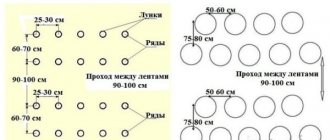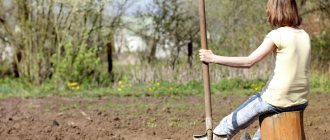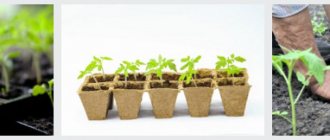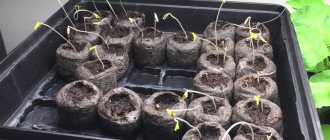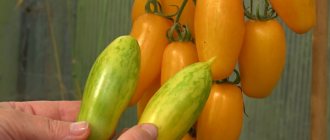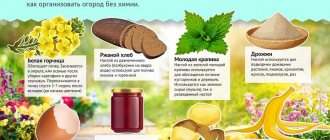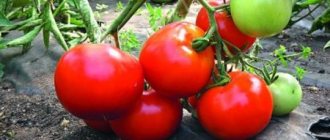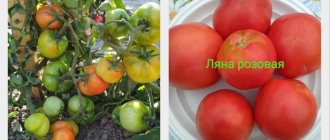When to sow tomatoes for seedlings in 2021 in Siberia is the main question for gardeners. Planting dates are of concern to everyone who is passionate about gardening and wants to get a rich harvest of these ripe and sweet fruits.
Dear readers! For you, we have created communities on social networks in which useful articles and interesting ideas are published several times a day! Subscribe and receive useful content in a convenient format!
Tomatoes are one of the most famous and sought-after plants and, in general, are quite undemanding in terms of care.
But for several decades, according to the recommendations of experienced gardeners, it is preferable to sow tomatoes as seedlings, and then transplant them into the ground on favorable days of the lunar calendar.
When to sow tomatoes for seedlings in Siberia in 2021, planting dates according to the lunar calendar?
Experienced gardeners usually use the lunar calendar as a guide, using it to determine the most successful days for planting tomatoes. It is no secret that lunar phases can favorably influence the growth and development of crops.
The lunar calendar allows gardeners to figure out which day will be the most favorable and safe for planting grains of this crop.
Feeding tomato seedlings
Tomatoes are usually fed with organic fertilizers. Experienced vegetable growers can dilute solutions of the desired consistency themselves. It is preferable for novice gardeners to use store-bought preparations. So, the first feeding can be done with the drug “Agricola-Forward”. A teaspoon of dry matter is diluted in 1 liter of water and the plants are watered. The time of the first feeding is determined by the appearance of one full leaf.
The second fertilizing is applied when the tomato grows three full leaves. For this purpose, the drug “Effekton” is used. The solution is prepared from 1 liter of water and 1 tbsp. l. dry fertilizer. The next feeding is carried out 14 days after picking. The solution is prepared from 10 liters of water and 1 tbsp. l. nitroammofoski. Half a glass of liquid is poured under one plant.
The penultimate feeding is done 14 days after transplanting the seedlings into large pots. The solution is prepared with 10 liters of water plus 1 tbsp. l. potassium sulfate. The last fertilizing is applied shortly before planting. Under each plant, pour 1 glass of solution prepared from 10 liters of water and 1 tbsp. l. nitrophoska.
Which tomato varieties are suitable for planting in Siberia
Taking into account the weather conditions of the Siberian region (short summer, little heat, sudden weather changes), experienced gardeners recommend choosing those tomato varieties that meet the following requirements:
- good tolerance to sudden changes in temperature;
- quick friendly return of fruits;
- ability to bear fruit in unfavorable conditions;
- good taste and product quality.
By paying attention to these requirements, even an inexperienced gardener can choose a good variety of tomatoes that will give a rich harvest of this medium-sized and tasty vegetable.
Taking into account all the above requirements, the following varieties of tomatoes can be recommended as varieties and hybrids for Siberia: Siberian Kiwi, Beautiful Lady, Orange Boy F1, Lelya, Ultra-Ripe, Bulat, Metelitsa, Aphrodite F1, Siberian Lights, Ground Gribovsky, Scarlet Candles, Bychiy forehead, Siberian surprise, Budenovka, Velvet season, Pink honey, Alsou, Abakan pink, King of Siberia, etc.
Features of the climate in the region
Siberia occupies more than 60% of the area of all of Russia. It lies in three climatic zones: temperate, subarctic and arctic. Weather conditions in different parts of Siberia can differ significantly. Tomatoes are not grown in all areas. In some regions it is too cold, and crops with such a long growing season simply do not have time to ripen. In addition, they are not adapted for cultivation in the Arctic climate.
Most Siberian territories are heavily swamped. This affects the temperature regime. In summer, with high air humidity, daytime temperatures noticeably decrease. Winter in Siberia is cold and long. Summer can be hot, but it is always short. In the eastern regions the climate is sharply continental. There is a sufficient amount of precipitation in the described area.
When is the best time to sow tomatoes in Siberia, choose the time
It is customary to plant tomatoes as seedlings in the Siberian regions in the early to mid-first month of spring. But this period is not a limitation that does not allow the crop to be planted at another time, since the date is determined by the place where adult specimens are planted.
Despite the unfavorable climatic conditions, gardeners in Siberia grow tomatoes in a greenhouse, greenhouses or in the garden.
Each method has its own time for planting this sweet crop, so everything is relative.
As mentioned above, gardeners determine the date of planting tomatoes by the future location of the plants:
- if the method of growing tomatoes is indoors (greenhouse), it is better to start sowing tomatoes for seedlings after mid-February and until the end of the first spring month;
- if tomatoes are planted under film in the garden, it is better to plant in March;
- When planting a tomato in an open garden that does not provide any protection, it is recommended to start sowing from mid-March until the tenth of April.
LET'S SUM UP : gardeners begin to sow tomato seeds in a greenhouse several months before planting, and tomatoes that are intended for planting in an open garden are planted 2.5-3 months before transplanting.
Seed preparation in Siberian conditions
A few days before sowing, it is necessary to select and prepare the material. Dissolve a tablespoon of salt in a glass of warm water and throw in the seeds. Those that float to the surface are discarded. You can also make a selection manually, selecting only strong and healthy specimens, while broken and diseased specimens should be discarded. For the purpose of disinfection, they are subsequently soaked in an iodine solution at the rate of 3 drops per 100 ml of water. Keep the seeds for half an hour and then start sowing.
Experienced gardeners germinate seed to increase germination. For these purposes, use a damp piece of cloth, in which the seeds are wrapped and sent to a warm place. After a couple of days, the sprouts should emerge.
Favorable time for planting tomatoes in 2021 according to the lunar calendar in Siberia
You can plant tomatoes from February until the end of April, however, you need to choose more favorable days for this, relying on the phases of the lunar calendar.
So, the best days this year for planting tomatoes are:
- February: from 12 to 26.
- March: from 14 to 27.
- April: from 13 to 26.
- May: from 12 to 25.
On other days, summer residents can safely prepare the soil for planting tomatoes.
Caring for sprouted tomato seedlings
After the sprouts appear, the film covering is removed from the boxes, but kept at the same temperature for at least 7 days for the plants to adapt. Next, the seedlings are reduced to room temperature to +17°C for a week. The tomato seedlings will get stronger and will continue to grow during the day at a temperature of +19°C, and at night the temperatures should be reduced to +15°C. You can regulate the temperature inside the room by opening the window, the main thing is that there is no draft. This temperature regime is maintained for about 1 month until two full leaves appear.
Attention! After the tomatoes sprout, the sprouts develop slowly for the first three weeks, only then do they grow intensively for 2–3 weeks.
Plants standing by the window are sure to reach for the light. The boxes must be rotated periodically to avoid elongated, uneven stems.
Unfavorable time for sowing tomato seedlings in 2021 in Siberia
Unfavorable dates for sowing tomato seeds in 2021 are as follows:
- February: 11th, 27th.
- March: 13th, 28th.
- April: 12th, 27th.
- May: 11th, 26th.
IMPORTANT! You should take into account various life situations that may contribute to the impossibility of working within the numbers recommended above. In this case, experienced gardeners resort to neutral days, that is, those that are neither favorable nor unfavorable.
The weather can also be a hindrance.
Therefore, when planning sowing in the ground, it is necessary to review the long-term weather forecast and forecasters’ assumptions regarding precipitation and other factors compiled specifically for such cases.
Sowing tomato seeds in the ground
If peat tablets are not used, tomato grains are sown in common boxes or in separate cups. The sowing principle is the same. If cups are used, it is advisable to place them in an empty box for ease of transportation.
So, it is necessary to make holes in the soil 1.5 cm deep. If sowing is carried out in common boxes, grooves are cut with a distance between rows of 5–7 cm, where the grains are laid out in increments of 2 cm. For separate cultivation, 3 holes are squeezed out into glasses in the ground. One grain at a time is placed here. All grooves with seeds are covered with loose soil. Do not overfill the soil with water. It is enough to lightly moisten the groove before sowing the tomato seeds, and then moisten the entire soil with a sprayer when the grooves with the seeds are filled.
Before young tomato sprouts appear on the soil surface, it is necessary to create a favorable microclimate. The boxes are covered with glass or transparent film and placed in a warm, lighted place.
Important! The optimal air temperature in the room where tomato seeds germinate is +25°C.
What is the best way to sow tomatoes for seedlings in Siberia, tricks
When the sowing time has come, you can begin directly planting home seedlings. However, before sowing tomato seeds, you need to prepare the soil, pots and other material.
Preparing the soil needed for planting
Soil with a neutral composition and favorable parameters is considered an important condition for the fruitful cultivation of crops. You can buy soil at hardware stores or make it yourself. Experienced summer residents recommend starting to prepare the soil a week before sowing.
IMPORTANT TO REMEMBER! For the seeds of this crop, it is necessary to have specialized soil intended specifically for tomatoes. You can buy this soil in almost every store.
In addition, there are quite popular rumors, which have been confirmed more than once by the positive experience of gardeners: at the time of preparing the soil, it is worth adding soil taken from the garden, into which the seedlings will subsequently grow. This manipulation makes it possible to reduce the stress of the plant during transplantation and will help it quickly adapt to the new soil.
DO NOT FORGET! Before sowing seedlings into the soil, no matter whether purchased or prepared with your own hands, it must be subjected to a disinfection procedure, that is, placed in the oven and heated for 30-40 minutes.
How to choose a suitable container for seedlings
In order for the seedlings to be comfortable and have plenty of free space for development and growth, it is important to choose a suitable pot for it, which will be the “home” for the tomatoes for the next few months. At the gardening store you can find pots of any material and size.
The main thing is to take into account the number of grains sown so that later the seedlings are not crowded.
How to choose seeds for seedlings
When choosing grains for tomato seedlings, do not forget that literally everything depends on the quality of the seeding material: from the health of the tomatoes to a rich and sweet harvest. Experienced gardeners advise purchasing seedlings from reliable manufacturers who produce exceptionally high-quality products.
NOTE! When buying tomato seeds for seedlings, look not only at the manufacturer’s advice and beautiful packaging, but also at the expiration date. Gardeners advise purchasing seed produced no more than two years ago.
In addition, in addition to the option of purchasing seedlings in specialized stores and online markets, grains can be collected and stored for sowing in the future.
How to prepare soil for planting tomatoes for seedlings?
You will need:
- peat,
- sand,
- ash.
For a bucket of peat you should take half a bucket of sand and a liter jar of ash. Instead of ash, you can take a 0.5 liter jar of chalk or a glass of lime or dolomite. Peat is sold in stores for gardeners, sand and chalk can be found in construction departments. Instead of peat, you can use coconut substrate - one briquette per bucket of water). It is better to pour boiling water over the coconut substrate briquette for swelling (again, for disinfection), and then cover with a lid to cool completely.
This soil for tomato seedlings does not contain mineral fertilizers, so you need to add 3 tablespoons of complex mineral fertilizer to a bucket of peat. Tomato seedlings at home will grow better if you water the seedlings not with water for irrigation, but with a weak raster of such fertilizer. 1 teaspoon of mineral fertilizer for seedlings is diluted in 3 liters of water. You can use liquid fertilizer. Complex fertilizers contain not only nitrogen, phosphorus and potassium, but also microelements.
Sowing tomato seeds for seedlings step by step
To properly plant tomato seedlings and avoid basic mistakes, pay attention to the instructions below.
- Place a thin drainage layer at the bottom of the container. The role of drainage can be played by: expanded clay, small stones and other materials.
- Pour the pre-prepared soil into the box, water it well and let the moisture saturate the soil.
- After the water has been absorbed, the soil surface must be divided into rows. The depth of the holes should reach one centimeter, and the distance between the rows should be 4-5 centimeters.
- Sow tomato seedlings in these holes.
- Lightly dust the top with soil (no more than 5 mm).
- At the end, you need to irrigate the soil with a spray bottle and cover the container with glass or polyethylene.
- Place the container in a warm and bright place.
Unfavorable landing days
The lunar calendar indicates dates on which it is better not to sow tomatoes for seedlings or replant seedlings. Astrologers do not recommend carrying out such work on the waning moon, new moon and full moon. However, the recommendation regarding the decline phase is not strict. Such periods last on average 2 weeks. If you urgently need to sow seeds or transplant seedlings, it is better to do it on an unfavorable day than to delay the deadline and be left without a harvest. In this case, it is advisable to insure yourself. For example, seeds should be soaked in water for 30 minutes to improve germination. Before transplanting into open ground, plants need to be treated with Epin. This will reduce possible risks.
Features of caring for tomato seedlings in Siberia
Although tomato seedlings do not require any specific care, they are worth keeping an eye on and creating comfortable conditions.
Watering
This procedure should be carried out with great care and only after the soil has dried. If tomatoes grow in constantly damp soil, there is a high risk of them rotting quickly. Water the plant with infused water at room temperature.
Additional lighting
If tomato seedlings don't get enough light, they will begin to stretch out. Therefore, the bushes will have to be provided with light for 12-14 hours a day.
Top dressing
A crop that grows well, develops and has a thick, healthy stem does not need to be fed. However, if short soil was used during planting and the grains do not germinate well, the tomatoes need to be fed.
Soil for growing tomato seedlings
Many vegetable growers are accustomed to preparing their own soil for growing tomato seedlings. The basis is a mixture of equal proportions of humus, garden soil and peat. Sometimes, for disinfection, the soil is kept in the cold for a long time. In Siberian conditions this is not difficult to do. You can bake the soil for about 30 minutes in the oven at a temperature of 100°C. It is important to add nutrients that serve as feed for tomato seedlings. For 1 bucket of soil, add 10 g of urea, potassium sulfate, and superphosphate.
If you haven’t had time to stock up on soil since the fall, you can buy ready-made soil in every specialized store.
The ones that have proven themselves best are:
- Coconut substrate is good for growing tomatoes for seedlings. Plants grow strong with a developed root system.
- Fans of the traditional growing method prefer ready-made soil for tomatoes “EXO”. If the store does not have soil specifically for tomatoes, you can use universal soil.
- Peat tablets are considered the best and most convenient for growing tomato seedlings. In addition to the fact that plants develop well in them, briquettes save the gardener from unnecessary work associated with picking tomato seedlings. 2–4 tomato seeds are planted in each tablet with a diameter of 40 mm. After germination, one strong seedling is left, and the rest are torn off. When the time comes for transplanting, the tomato seedling along with the tablet is simply immersed in the soil of a half-liter container.
Each vegetable grower uses the type of soil that is easier for him to work with and cheaper.
Common mistakes
When growing tomatoes in their gardens, summer residents often violate the rules of agricultural technology and make primitive mistakes. They can lead to plant diseases, death, or a modest harvest. The most common mistakes are
- wrong choice of seedlings: not suitable for the climate, etc.;
- unsuitable soil;
- use of contaminated land;
- premature landing;
- excess moisture and frequent watering;
- late transfer of seedlings to an open garden;
- dense sowing of grains in a container;
- preventive work against late blight is not carried out;
- later removal of stepchildren.
NOTE! Planting overgrown tomato seeds can lead to late flowering, and consequently the absence of ovaries on the very first tassels.
Features of cultivation
Tomato seeds for Siberia must be chosen carefully. Not all of them are suitable for harsh climates, especially open ground. Siberian tomato varieties should be cold-resistant and have a not very long growing season. Resistance to low temperatures, especially in high moisture conditions, is also a big plus. Tomatoes that are tolerant to most diseases to which this crop is susceptible are suitable for growing in regions with cold climates. The varieties of Siberian selection are ideal:
- Nobleman;
- Alsou;
- Beauty of Siberia;
- Eagle beak;
- Buffalo heart.
It is worth paying attention to large-fruited tomatoes. Unfavorable environmental conditions negatively affect tying. Large-fruited varieties give an excellent harvest even if relatively few fruits are set. Varieties and hybrids that bear fruit even in difficult conditions are excellent for canning, but their fruits are not very large in size. These include the varieties Chukhloma, Vidomo-invisibly, as well as hybrids Intuition and Semko.
Answers to frequently asked questions
How often to water seedlings?
Watering should be done when the soil dries out. Excessive amounts of moisture will lead to plant diseases or rotting.
What additional lighting should I use for favorable growth and development of seedlings?
You can use a lamp, setting it above a container. As soon as the sun sets outside, we turn on the lamp.
Is planting seeds on neutral days according to the lunar calendar fraught with plant diseases and slow development?
Some people, due to life circumstances, do not have the opportunity to sow seeds on favorable days according to the lunar calendar. There are neutral numbers for this, where planting seedlings is also encouraged without further adverse consequences.
Organization of watering tomato seedlings
Watering young plants is carried out with warm, settled water in small doses directly at the root. During the entire germination period before picking, tomato seedlings are watered three times. The first watering is carried out 10 days after sowing. By this time, the film had already been removed from the boxes, and the sprouts had all appeared on the surface of the soil. The seedlings are watered for the second time after 7 days, and the last third time - 2 days before picking.
Seedlings should not be over-watered. High dampness will prevent oxygen from reaching the roots and rot will begin to form. The soil under the plant should be loose and slightly moist. Frequent watering will be needed after picking, when the plant has 5 full leaves. During this period, the frequency of watering can reach every two days.
The best conditions for growing tomatoes from seeds
Healthy and strong tomato seedlings are the key to future productivity. Many novice gardeners make mistakes when growing tomatoes. We will discuss important nuances so that in the future you can get a bountiful harvest without unnecessary labor costs.
So, tomato seeds are usually planted from February to early April. As a rule, the first shoots appear after 5-10 days. After this, the seedlings are grown on a windowsill or in a greenhouse for 45-65 days.
It is important that it does not overgrow in pots. Otherwise, the growth of an adult plant will be inhibited in the future, which will lead to a decrease in yield.
When growing seedlings, important factors are: sufficient lighting, humidity and temperature of the surrounding air, as well as the soil. The table below shows the optimal air temperature ranges for growing tomatoes using the traditional method:
| Development period (phase) | Daytime air temperature, °C | Air temperature at night, °C |
| From sowing seeds to first shoots | about 25 | about 25 |
| After germination and appearance of leaves | 20 | 16 |
| After the dive: | ||
| - with additional lighting | 18 | 16 |
| — without additional illumination | 16 | 14 |
| The first days after transplanting into pots | 15-16 | 14 |
| During the growth period of seedlings in pots*: | ||
| - sunny days | 16-18 | 14-15 |
| - cloudy days | 13-15 | 13 |
* when additional lighting is applied, the temperature is usually 2°C higher.
You may be interested in: Planting dates and features of growing osteosperm from seeds for 2021 Dates and rules for planting Eschscholzia from seeds for 2021 Dates and rules for planting statice from seeds for 2021 To reduce the temperature, you can open the window or balcony at night. At the same time, sudden jumps and drafts should not be allowed.
Tomato is a heat-loving and light-loving plant. It is good when the windows on which the seedlings stand face south and the daylight hours are at least 16 hours. Otherwise, assimilation lighting (additional lighting) will be needed.
There are special fluorescent lamps that emit a certain range of spectra that promote growth. Almost all spectral light fluxes have their own benefits.
For example, the red spectrum accelerates seed germination and stimulates vertical growth of seedlings. Blue and purple - increase the rate of cell division and promote their proper formation. Green and yellow are not particularly important, but they maintain a balance between the other spectra to avoid skew in one direction or another.
The feasibility of using additional lighting can be determined by the weather outside the window. In normal weather and clear skies, there is no need to turn on additional lighting for the whole day. It is enough to do this for 2.5-3 hours in the early morning and evening. That is, before sunrise and after sunset. If the day turns out to be cloudy, and it seems that twilight has already arrived at noon, then it is better not to save money and turn on the additional lighting earlier.
It is important to maintain high (60-70%) air humidity.
To do this, seedlings are sprayed 1-2 times a day or automatic air humidifiers are used (in greenhouses). But the main thing here is not to overdo it: very high humidity threatens the tomato with late blight and the development of rot.
Make sure the soil moisture is 70-75%. Since it is quite difficult to determine by eye the percentage of moisture contained in the soil, it is recommended to water the seedlings every other day, when the soil becomes clearly dry. Remember - tomatoes love rare but abundant watering.
The temperature and composition of water for irrigation are also very important. It is better to use boiled, rain or melt water heated to 25 degrees. Fresh tap water can have a depressing effect on young plants.
It is better to use boiled, rain or melt water
Common mistakes and ways to avoid them
Different varieties are suitable for greenhouses and open ground, so this nuance is thought through at the planning stage. The next step is drawing up a work plan. 24 hours before the new moon, weeds and traces of last year's harvest are removed. Damaged shoots must be harvested, otherwise they will become a breeding ground for pests. A day before the new moon, they loosen the soil and collect seeds. The seed collected on the eve of the new moon is characterized by increased resistance to pests and diseases.
| Moon phase | Description | What you are allowed to do |
| Growing | The duration of the period does not exceed 10-12 days | Plant seeds, loosen the soil, replant young shoots |
| Full moon | Lasts up to 15 hours | Remove weeds, treat seedlings against weeds and pests, form a bush |
| Descending | The duration of the period is up to 12 days | All types of work near the root system are prohibited; no picking or replanting of seedlings is allowed. |
Compliance with the listed recommendations, based on the phases of the moon and human observations, does not guarantee a good harvest. Botanists urge regular inspection of plantings. As soon as signs of pest activity or disease are detected, the area is treated with a fungicide, and the affected tomato is disposed of. 1-2 sprayings with an interval of 5-6 days are enough.
On a note!
If the leaves turn pale or curl, check the light level or soil accordingly. The problem is solved by increasing the level of illumination or more intensive watering.
In the Siberian region, field work begins in April. The date is chosen taking into account the lunar calendar and the characteristics of the variety. Tomato is an unpretentious crop that requires moderate watering and fertilizing.
How to plant seedlings in greenhouses
In warmer areas of Siberia, tomato seeds can be planted directly in greenhouses. The rows should be 4 cm apart from each other, and in a row the distance between tomato seeds is 2 - 3 cm. The seeds are laid out in the ground and sprinkled with a 1 cm mixture of humus soil and sand, sifted through a sieve. After sowing, the temperature in the greenhouse must be maintained at 20–25°C, and the greenhouses themselves must be covered with mats and frames at all times.
The first shoots begin to appear after about 6-7 days, and when the plants begin to sprout en masse, the greenhouse should be ventilated so that the temperature is set at 10-12°C.
Attention! If the air is overheated, the tomato seedlings will stretch out.
After a few days, the temperature should be raised to 20 - 25°C, and at night it should be reduced to 10°C.
You should prepare for the fact that the tomatoes will grow very slowly for the first 20 days, and then a breakthrough in growth will occur.
Picking tomato seedlings
Tomato picking usually occurs 10–15 days after germination. Many vegetable growers immediately transplant seedlings into separate large cups. As practice shows, for the first picking it is advisable to take small half-liter containers. The glasses are filled with soil and watered with a weak solution of potassium permanganate at a temperature of about 23°C. All seedlings that have 3 full leaves are carefully lifted with a spatula and placed in a separate cup. Slightly elongated sprouts are buried to the level of cotyledon leaves.
Immediately after picking, the plants should not be exposed to sunlight. It is necessary to ensure the indoor air temperature during the day is +21°C, and at night +17°C. As they grow, after 3 or 4 weeks, the tomatoes are transplanted into large containers where they grow until planted in the ground.
Why is it important to respect the timing of sowing tomato seeds?
Siberia has always been positioned as a special zone associated with risky agriculture. Based on unstable and harsh weather conditions, it is recommended to grow tomatoes in this region in greenhouse complexes or greenhouses.
The timing of sowing seeds is the main criterion for obtaining a high-quality and abundant harvest of vegetables.
- Spring in the Siberian region comes much later than in temperate climates. This means that the soil warms up only by mid-June.
- Seedlings planted in mid-February are greatly overgrown by the time they are transferred to a permanent place of growth. And, as you know, overgrown plants are more difficult to take root, which as a result affects the quality and quantity of the harvest. Such plants are often damaged by diseases and harmful insects.
- Tomatoes are a light-loving crop, and at the end of winter the daylight hours are still short, which means that without sufficient sunlight, the seedlings will stretch out and become weak and frail.
Advice! It is necessary to take into account the method of growing vegetables. For greenhouse cultivation, tomatoes are planted 2-3 weeks earlier than in open ground.
Sowing technique
You can sow tomatoes in any capacious container at least 10 cm high with drainage holes. Its bottom is sprinkled with drainage - small crushed stone, expanded clay, crushed eggshells.
The soil
Light and loose garden soil with a neutral pH level is suitable for sowing. To improve nutritional value, it can be mixed with sand and humus in a ratio of 1:1:1.
Before placing it in a container, the soil is spilled with a raspberry solution of potassium permanganate or calcined in the oven to destroy pathogenic microflora, which can cause various diseases in seedlings.
Some gardeners use ready-made substrate for growing vegetables.
Sowing scheme
Depending on the type of container, the sowing pattern will be different:
- in seedling boxes or containers, seeds are sown in grooves up to 1 cm deep and at a distance of 3-4 cm from each other;
- when sowing in peat pots, plastic cassettes or disposable containers (400 ml volume), seeds are sown to a depth of 1 cm, 1-2 pieces each. in each.
The crops are sprinkled with a thin layer of soil and irrigated with a spray bottle.
Sowing seedlings
Preparing seedlings is part of the complex work of planting tomatoes in a garden or greenhouse. Tomatoes are unpretentious in care: if the gardener sets the correct regime for the seedlings, they are ready for transplanting by the appointed time. Conditions for tomato seedlings:
- a large amount of light;
- high humidity;
- sufficient amount of heat.
If the seedlings do not receive the necessary fertilizers and moisture, their growth will slow down and by the time of planting, they will not be able to take root. The quality of the future harvest, which is planted exactly on time, directly depends on the readiness of the seedlings for transplanting. Seedlings are grown with a large amount of natural and artificial light: if it is dark in the greenhouse, it is necessary to install additional lamps. In a well-lit room, seedlings grow quickly.
Tomatoes for planting in open ground in Siberia must be sprayed at least 2 times a week. Humidified air is a favorable environment for the rapid growth of seedlings. By the time of planting, the seedlings should be healthy and strong. The optimal daytime temperature for tomato seedlings is from 18 to 25 °C.
Picking the root system
Picking is a method of pruning the root system that helps improve the growth of tomato bushes. To carry out the procedure, separate containers are used in which the treated plants are placed. After picking, tomatoes will grow faster in open ground. For the procedure and restoration of seedlings, an additional week is counted before planting the seedlings. After the procedure, the plant requires standard care: no watering is required for the first 3-4 days, monitor the condition of the plant - if signs of leaf wilting appear, you need to spray the seedling itself. It is necessary to spray with warm water -15-17 °C. On day 5, you can begin to regularly moisten the soil (gardeners advise doing this once every two days). As weeds appear, weed, and as the root system grows, hill up.
Pinching the root produces a lush root system that evenly feeds the entire bush. Plant one stem at a time in separate pots: prepare fertilized soil. Two seedlings are used in cases where early varieties do not take root well - two stems increase the chances of growing a healthy, full-fledged bush.
10 days before planting seedlings in the garden, they are hardened off. To do this, the temperature in the room where the seedlings are kept is gradually lowered. The minimum temperature drops to 16 °C. Such measures are especially important for cold regions like Siberia - after hardening the plant gets along better. 4 days before planting, pots with picked plants are taken outside. Under the influence of external environmental factors, physiological processes in seedling stems change.
Care and watering
For tomatoes that are planned to be planted, watering is important. The more moist the soil is, the faster the seedlings will begin to grow. It is important to moisten the soil with mineral fertilizers that strengthen the root system. But here it is important to adhere to the norm - watering the plants every other day (watch how the soil absorbs liquid, do not allow water to stagnate at the roots), irrigate the bushes - once every three days.
Before planting seedlings at the end of March or April, the stems are treated with Photosporin, which enhances the protection of seedlings. The open ground is moistened, and the next watering is planned no earlier than in a week.
Transfer rules
Seedlings need to be prepared for transplanting
The optimal time for transplantation is the end of May or the beginning of June. By this time, seedlings 50-60 days old will reach a height of 25-30 cm, produce 5-7 leaves and grow strong roots.
The soil
The tomato grows well and bears fruit on light and fertile soil with a low acidity level. Therefore, before planting, the site is fertilized with humus - 10 kg, wood ash - 3 kg, superphosphate and potassium sulfate - 100 g per m².
For deoxidation, add 300 g of slaked lime or dolomite flour.
Then the soil is dug up, leveled and irrigated with a urea solution (1 tablespoon per bucket of water) - it improves the quality of the soil and helps destroy all parasites and pathogens.
Site preparation is carried out two weeks before the planned planting of tomatoes. Two days before transplanting the seedlings, the soil is watered abundantly and loosened.
Scheme
Depending on the variety, it is necessary to plant greenhouse tomatoes in Siberia according to the following scheme:
- vigorous plants are planted at a distance of 50 cm from each other with a distance in a row of 60 cm;
- the optimal scheme for medium-sized crops is 40x50 cm;
- for short people - 30x40 cm.
Prepare holes according to the size of the plant root system, pour 0.5 liters of water into each hole. You can plant tomatoes after the moisture has been absorbed, the roots are lowered, sprinkled with ordinary soil without fertilizers and the soil is slightly compacted in the area of the stem.
To protect against drying out and ensure stability, the bushes are mulched with garden soil.
Sowing seeds in the ground
For this zone, it is better to use varieties that are resistant to cold and sudden temperature changes. Sowing is carried out according to the same scheme and timing as planting home seedlings in a greenhouse.
For seedlings, it is necessary to provide optimal germination conditions:
- temperature within 21-23°C;
- humidity at 55-60%;
- regular ventilation during midday hours;
- Irrigation with warm water as the top layer of soil dries.
Picking of seedlings is not carried out, since the seeds are initially sown at the required distance for the full development and fruiting of the bushes.
As they grow, the soil around the sprouts is watered, loosened and mulched. Weeds are also removed, which choke the plantings and take away all their nutrients and moisture.
When to plant tomatoes in Siberia?
TOMATOES IN SIBERIA Pulling out seedlings Part 1 Siberian Mini Dacha
These tomatoes can be sown in April. What varieties of tomatoes are good for open ground in Siberia?
